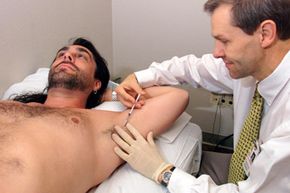Our body produces sweat to keep itself cool, which is why you'll notice it dripping when something causes your temperature to rise. But it's not just hot and humid weather that causes you to sweat: Exercise, physical stress, emotional stress and nervousness can also make you sweat. About 1 percent of Americans, however, sweat excessively (as much as four times the normal amount) just going about their daily lives as their bodies try to sustain a normal temperature [sources: The Society of Thoracic Surgeons, WebMD Health News]. It's a condition known as primary hyperhidrosis, and it most noticeably affects the palms of the hands, the feet and the armpits. People with this condition can be plagued with not only sweaty clothes and a soggy handshake, but also with skin infections and social embarrassment. This kind of sweat can't be tamed by over-the-counter antiperspirants. What does help? As it turns out, botulinum toxin type A, what we know as Botox.
Botox is the darling of celebrities because of its ability to smooth wrinkles, but it can also stop your sweat. This cosmetic treatment is actually a neurotoxin produced by the bacteria Clostridium botulinum (which is found in soil). It adversely affects our muscle control, causing drooping eyelids and blurry vision, difficulty breathing and swallowing, muscle weakness and paralysis. This ability to paralyze is what makes it useful in fixing furrows and, as it turns out, treating excessive sweating.
Advertisement
Our skin -- specifically the middle layer, or dermis -- isn't made up of just collagen and elastin -- it's full of sweat glands, hair follicles, sebaceous glands (these produce oil), blood vessels and nerve endings. Our body secretes sweat from two types of glands, the eccrine and apocrine glands. Eccrine glands are located in the skin, all over the body. Apocrine glands, on the other hand, are located in places on the body where there's a high concentration of hair follicles, such as the scalp, armpits and groin area. These glands are controlled by the sympathetic and parasympathetic nervous systems, the command center that also controls involuntary bodily functions such as breathing, digestion, body temperature, heart rate and blood pressure. When you have an increase in body temperature, your sympathetic nervous system automatically signals the sweat glands to cool your body.
When Botox is injected into the skin, the treatment affects the signal between the nerve endings and the sweat glands in the dermis. The botulism toxin binds itself to the nerve endings near the injection site and acts like a roadblock. It blocks the release of the neurotransmitter acetylcholine, a chemical our nerve cells make to communicate with each other, and this disrupts the message sent from the nerve endings to stimulate the production of sweat. The sweat glands are none the wiser.
In 2004, the U.S. Food and Drug Administration approved Botox injections to treat axillary hyperhidrosis (excessively sweaty armpits), and some doctors use it to treat palmar hyperhidrosis (excessively sweaty palms) and plantar hyperhidrosis (excessively sweaty feet). Each treatment may include several injection points concentrated in the affected area, and each treatment is expected to last about six months. Don't worry about blocking the sweat from one or two small areas of the body -- there are plenty of sweat glands to handle the job.
Advertisement
